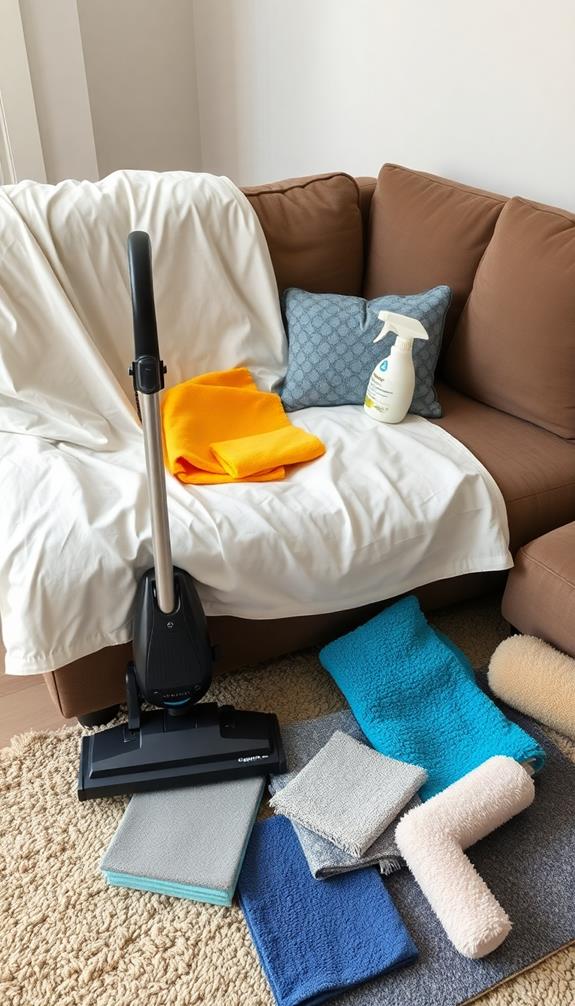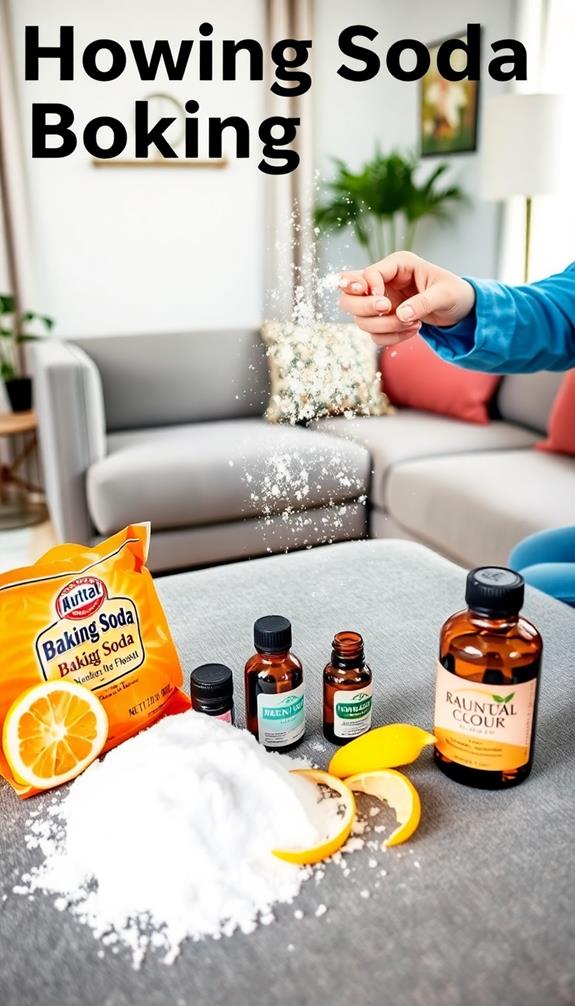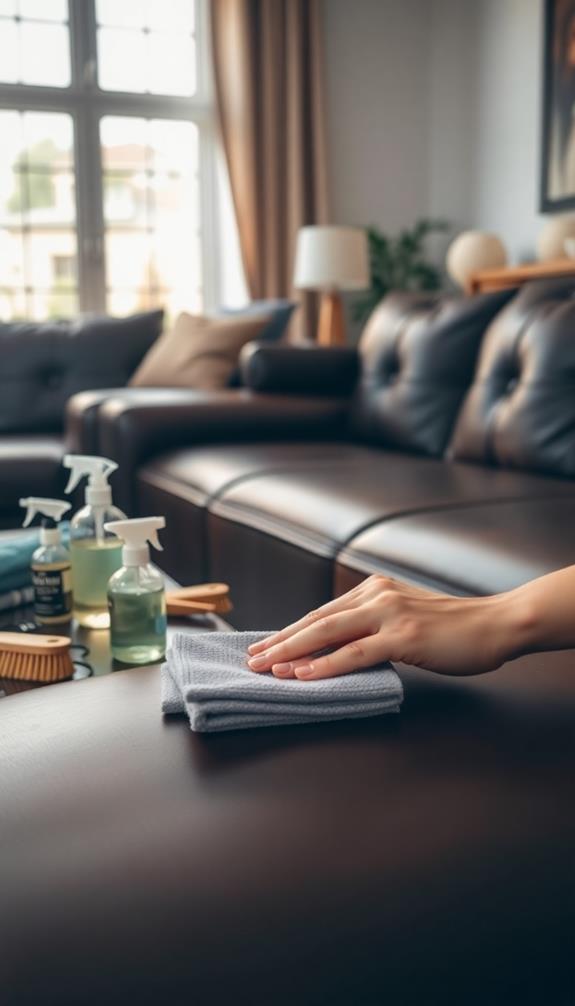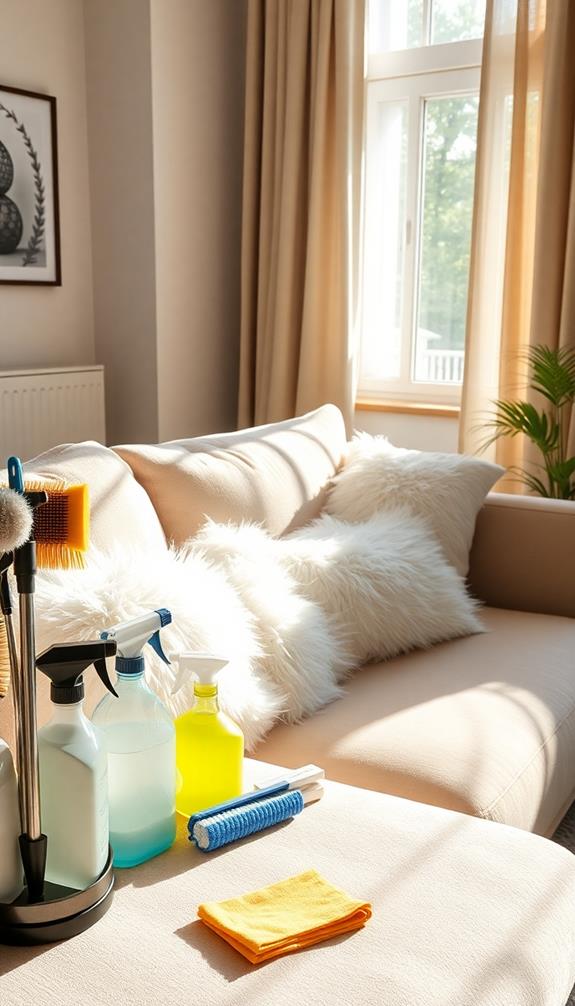To deep clean your couch, start by vacuuming it thoroughly, including under the cushions. Check the care label for cleaning codes to choose the right method. For fabric upholstery, mix 2 cups distilled water, 2 tablespoons of Dawn dish soap, and 2 tablespoons of vinegar for spot cleaning. Sprinkle baking soda for odors, let it sit for 30 minutes, then vacuum it up. For leather couches, use a damp microfiber cloth and a leather cleaner. Regular maintenance is key, ensuring your couch remains fresh. Stick around to discover more tips and techniques tailored to each fabric type.
Essential Cleaning Supplies
When you're ready to deep clean your couch, having the right supplies on hand makes all the difference. Start with a vacuum cleaner equipped with an upholstery attachment. This tool is essential for vacuuming up loose dirt, hair, and debris before you plunge into deeper cleaning.
Regular maintenance, including using handheld vacuums, can streamline the cleaning process to prevent dirt buildup. Next, grab some baking soda; it's a fantastic odor absorber. Sprinkle it on your couch and let it sit for about 30 minutes to neutralize any unpleasant smells.
For spot cleaning, you can whip up a DIY Couch Cleaner using 2 cups of distilled water, 2 tablespoons of clear Dawn dish soap, and 2 tablespoons of distilled white vinegar. This solution works well on various fabric types.
Before applying any cleaner, remember to conduct a spot test to verify your fabric can handle it without damage.
If you're tackling stubborn stains or want a thorough refresh, consider using an upholstery cleaning machine. These machines utilize steam and specialized cleaning solutions to provide a deeper clean, revitalizing your upholstery.
With these essential supplies in hand, you're well on your way to a clean, fresh couch!
Understanding Cleaning Codes
Before you start cleaning your couch, you need to check the cleaning codes on its upholstery label.
These codes tell you which cleaning methods are safe for your fabric, helping you avoid damage. For instance, understanding whether your fabric is water-cleanable or requires solvent-based cleaners is essential for effective cleaning.
This knowledge can save you from potential mishaps related to improper cleaning techniques, such as following expert cleaning tips.
Understanding these codes will make your deep cleaning process more effective and protect your investment.
Importance of Cleaning Codes
Cleaning codes are essential for anyone looking to maintain the appearance and longevity of their couch.
These codes, found on upholstery tags, guide you in selecting the right cleaning methods for your specific upholstery fabrics. For instance, if you see a "W," it means you can safely use water-based cleaners. On the other hand, an "S" indicates that only solvent-based cleaning products should be used to avoid damaging the fabric.
If your couch has an "S/W" code, you've got more flexibility, allowing both water- and solvent-based cleaners.
However, an "X" code restricts you to vacuuming or light brushing, prohibiting any cleaning solutions. Ignoring these cleaning codes can compromise fabric integrity, leading to stains or deterioration over time.
Types of Cleaning Codes
How can you determine the best way to care for your couch? Start by checking the upholstery tags for cleaning codes.
These codes provide vital guidance on safe cleaning methods tailored to various fabric types. For instance, if you see a "W," it means you can use water-based cleaners. On the other hand, an "S" indicates that only solvent-based cleaners are safe.
If your couch is labeled "S/W," you've got the flexibility to use both water- and solvent-based cleaning agents. However, if the code is "X," you should only vacuum or brush the fabric—no cleaning products allowed to avoid damage.
Understanding these cleaning codes is essential. They help you select the right cleaning products, preventing fabric discoloration or deterioration.
This knowledge not only preserves your furniture's appearance but also extends its lifespan. By following these codes, you guarantee your couch stays looking fresh and vibrant for years to come.
Preparation Before Cleaning

Before you start cleaning your couch, check the care label for specific instructions on fabric types to avoid any damage.
Regularly vacuuming your couch can help reduce the amount of dirt and debris, making the deep cleaning process easier.
Next, gather all your cleaning supplies, like a vacuum, cleaning solutions, and cloths, to make the process smoother.
This preparation sets you up for a successful deep clean, ensuring you have the right tools for cleaning upholstery effectively.
Check Care Labels
Checking the care label on your couch is essential for ensuring you choose the right cleaning method. It provides significant information that helps you avoid damaging the fabric.
Here are four key steps to follow:
- Look for cleaning codes: Identify the symbols on the label. "W" means you can use water-based cleaners, while "S" indicates only solvent-based cleaners are safe. An "X" means you should only vacuum.
- Understand fabric requirements: Some materials, like silk or velvet, may need professional cleaning. If your couch is made from these delicate fabrics, don't attempt to DIY.
- Consider mixed codes: If you see an "S/W" code, you have the flexibility to use both water- and solvent-based cleaners. This can make your cleaning process easier.
- Follow manufacturer's guidelines: Adhering to these instructions is essential for maintaining the fabric's integrity and extending the lifespan of your couch.
Gather Cleaning Supplies
As you prepare to deep clean your couch, gathering the right cleaning supplies is vital for achieving the best results. Start by collecting a vacuum cleaner with an upholstery attachment, a soft-bristle brush, and microfiber cloths. These tools will effectively remove dust and debris from your couch upholstery.
Next, you'll need cleaning solutions. Consider OxiClean White Revive, mild dish soap, or create a DIY cleaner with distilled water, clear Dawn dish soap, and distilled white vinegar. This guarantees you have the right product for your fabric type.
Don't forget to prepare baking soda in a large box; it's great for absorbing odors and freshening up the fabric before you start deep cleaning.
Make sure to have clean, lint-free cloths on hand for wiping and blotting stains. This is vital for avoiding any residue left behind.
Finally, review the manufacturer's cleaning guidelines and fabric care labels. By understanding these details, you can select the most appropriate cleaning methods and products tailored to your specific couch upholstery.
With everything gathered, you're ready to plunge into the deep cleaning process!
Step-by-Step Cleaning Process
Start by removing the cushion covers and vacuuming the upholstery to get rid of hair, dirt, and debris. Focus on creases and the spaces between cushions, guaranteeing every nook is clean.
To tackle any stubborn stains, consider using natural cleaning solutions such as a vinegar and water mixture for effective results.
Follow these steps for a thorough deep cleaning of your couch:
- Wash the cushion covers on a cold/gentle cycle with OxiClean White Revive and baking soda. This not only brightens but also absorbs odors.
- After vacuuming, sprinkle a generous amount of baking soda on the couch. Let it sit for about 30 minutes to effectively absorb any lingering odors before vacuuming it off.
- Mix a DIY cleaner using 2 cups of distilled water, 2 tablespoons of clear Dawn dish soap, and 2 tablespoons of distilled white vinegar. Dampen a lint-free cloth with this solution, and gently wipe the fabric to clean your couch.
- Allow the sofa to air dry completely. Confirm no moisture remains, as this can prevent mildew or odors.
Deodorizing Techniques

To keep your couch smelling fresh, try simple deodorizing techniques like applying baking soda.
You can also consider making a homemade couch deodorizer by mixing water, vinegar, and fabric softener for a more potent solution that eliminates odors at the source.
Sprinkle baking soda generously, let it sit for a couple of hours, and then vacuum it up for a noticeable difference.
Regular freshening methods, like using fabric sprays, can also help maintain a pleasant scent in your living space, especially if you opt for customized scents using essential oils.
Baking Soda Application Tips
Your couch deserves a revitalizing boost, and baking soda is the perfect solution for deodorizing its fabric. This natural deodorizer effectively absorbs odors, giving your couch a fresh feel.
Here are some tips to maximize your baking soda application:
- Generously Sprinkle: Spread a generous amount of baking soda over the entire couch and let it sit for 1-2 hours. This allows it to absorb odors effectively before you vacuum it away.
- Washing Machine Boost: For couch cushion covers, add a cup of baking soda directly into the washing machine drum during the cleaning process. This step helps remove stubborn smells and refreshes your fabric.
- Spot Treatment: If there are specific areas that need attention, create a paste using baking soda and water. Apply it to the affected area, let it dry, and then vacuum it up. This technique helps remove stains and odors effectively.
- Monthly Maintenance: Incorporate baking soda into your monthly cleaning routine. Regular deodorizing not only keeps your couch smelling fresh but also prolongs its lifespan by preventing odor buildup from spills and pet dander.
Regular Freshening Techniques
Regular freshening techniques are essential for maintaining a clean and inviting couch. Start by regularly vacuuming your couch to remove dirt and pet hair. This simple step not only prevents odors from building up but also prolongs the life of the fabric.
When it comes to deodorizing, baking soda is your best friend. Sprinkle it generously on your couch, let it sit for 1-2 hours, and then vacuum it off. This process absorbs unpleasant smells effectively.
If you encounter spills or odors, don't wait—spot treat those areas promptly to prevent them from becoming permanent. For an additional layer of freshness, consider using fabric sprays like Febreze FABRIC. These sprays eliminate odors rather than just masking them, ensuring a truly fresh scent.
If your couch has removable covers, don't forget to wash them regularly as part of your couch cleaning routine.
Combining these techniques will help maintain a pleasant atmosphere in your living space. By incorporating these regular freshening techniques, you'll keep your couch looking and smelling great for years to come.
Special Care for Microfiber
While microfiber couches offer a soft and durable seating option, they also require special care to maintain their appearance and longevity. Understanding the fabric type can help you choose the right cleaning method and products, as some fabrics may need specific care techniques to avoid damage.
To keep your sofa looking its best, follow these simple steps:
- Testing: Always test your cleaning solution on a hidden area of the microfiber first. This helps prevent discoloration or damage.
- Cleaning method: For most stains, use rubbing alcohol as your cleaner. Spray a small section of the fabric and gently scrub with a light-colored sponge. You'll notice the stains lift onto the sponge.
- Blot the stain: If water stains appear, repeat the cleaning process using distilled water. This can effectively remove any residual marks without damaging the fabric.
- Upholstery brush: After cleaning, take an upholstery brush and restore the microfiber's plush texture by brushing in circular motions. This step guarantees the surface returns to its original appearance.
Cleaning Leather Couches

Cleaning leather couches requires a careful approach to preserve their elegance and durability. Start by using a microfiber cloth to gently remove crumbs and dirt from the surface.
Then, vacuum the couch with a crevice tool to get into seams and buttons, ensuring you capture all dirt and debris. For regular maintenance, consider implementing a method to tackle pilling, as it can affect the overall appearance of the couch, especially if it's upholstered with blended fabrics methods for pilling removal.
Next, check the cleaning code provided by your couch manufacturers for specific instructions. Apply a leather cleaner in small sections using a damp cloth, following the manufacturer's guidelines to avoid oversaturation.
Remember, using too much detergent can damage the leather. After you've completed the thorough cleaning, buff the leather with a dry cloth to restore its shine and remove any excess cleaner. This step is essential for achieving a polished finish.
To protect your couch from future stains and maintain its suppleness, consider applying a leather conditioner after cleaning. This additional step will help keep your leather looking its best for years to come.
If you're unsure or short on time, don't hesitate to reach out to professional cleaning services for assistance.
Removing Odors From Fabric
To banish unwanted odors from your fabric couch, start by identifying the source of the smell. Once you know where it's coming from, you can effectively tackle the issue.
This is essential because professional expertise guarantees thorough cleanup of deeply penetrated odors that may not be easily addressed with regular cleaning methods.
Here are some steps to help you remove odors:
- Use Baking Soda: Sprinkle baking soda generously on the affected areas. Let it sit for 1-2 hours to absorb the odors, then vacuum it up.
- Create a Cleaning Solution: Mix 2 cups of distilled water, 2 tablespoons of clear Dawn dish soap, and 2 tablespoons of distilled white vinegar. Use this solution to gently wipe the fabric with a lint-free cloth, focusing on areas with pet stains.
- Regularly Vacuum: Make it a habit to vacuum your couch at least once a week. This helps remove dirt, pet hair, and debris that can contribute to lingering odors.
- Apply Cleaning Sprays: Consider using fabric freshening sprays like Febreze FABRIC to eliminate odors instead of just masking them.
Additional Cleaning Tips

Maintaining your couch's appearance and longevity requires regular attention and effective cleaning strategies.
Begin by vacuuming your couch at least once a week. Focus on creases and under couch cushions to prevent dirt buildup. For quick maintenance, a lint roller is great for removing crumbs and pet hair.
When tackling stubborn stains, mix mild dish soap with warm water. Apply this solution directly to the stain and blot with a clean cloth to lift the mark without damaging the fabric.
If your couch requires deeper cleaning, consider using a cleaner with upholstery specific to your fabric type, especially for delicate materials. Always follow the manufacturer's recommendations to avoid damage.
After cleaning, don't forget to air dry your couch completely. This step is essential for maintaining fabric integrity and preventing mold growth.
If you've used baking soda to deodorize, vacuum the baking soda thoroughly, making sure no residue is left behind. If there are hidden areas, check there first to guarantee a thorough clean.
Benefits of Professional Cleaning
While regular upkeep is important, there are considerable advantages to hiring a professional cleaning service for your couch.
Professional cleaning can transform your upholstery and guarantee it looks its best. Here are some key benefits:
- Specialized Equipment: Professionals use specialized equipment that effectively removes dust, allergens, and stubborn stains, leading to a deeper clean than typical methods.
- Improve Indoor Air Quality: By eliminating up to 99.9% of bacteria and allergens, professional upholstery cleaning can greatly enhance the air quality in your home, promoting a healthier environment.
- Extend Its Lifespan: Regular professional cleaning helps maintain fabric integrity, preventing damage from grime buildup. This means your couch lasts longer and remains in great shape.
- Customized Cleaning Schedules: Many services, like Molly Maid, offer customized cleaning schedules tailored to your needs, so you don't have to worry about the hassle of DIY cleaning.
Investing in professional cleaning not only restores your furniture to its original condition but also enhances its aesthetics and comfort, ultimately maintaining the value of your upholstery over time.
Conclusion
Now that you know how to deep clean your couch, you can enjoy a fresher living space! Did you know that a clean couch can improve indoor air quality by removing dust and allergens? By following these steps and keeping your furniture in top shape, you'll not only extend its lifespan but also create a healthier environment for you and your family. So grab those supplies and get started—you'll love the difference a deep clean makes!